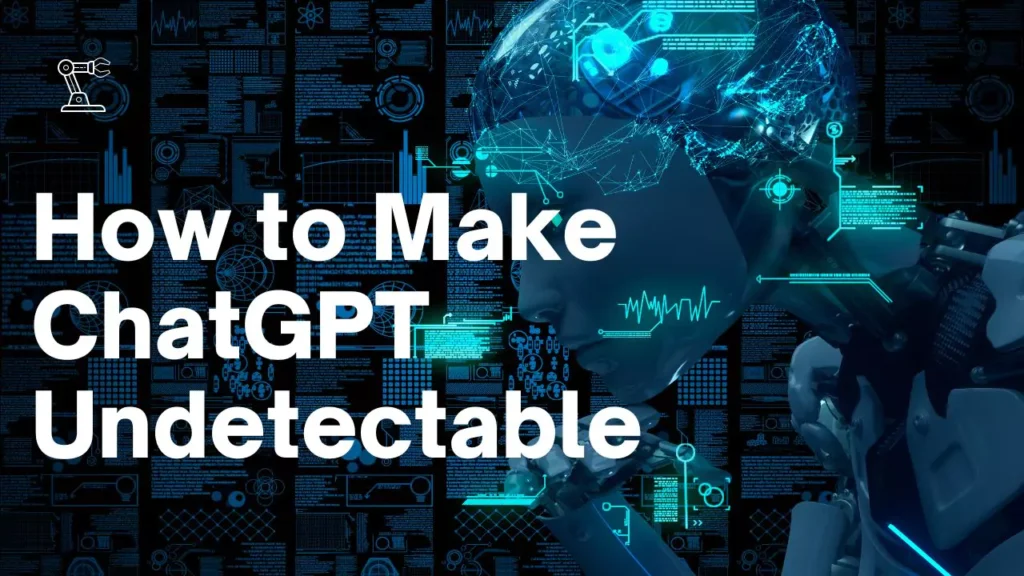Introduction
The rise of AI-powered chat services like ChatGPT has opened up new possibilities for content generation and assistance. However, with great power comes great responsibility, and concerns about ethical usage and authenticity have emerged. In this article, we will explore various methods and techniques to make ChatGPT-generated content undetectable while maintaining ethical standards.

A Brief Overview of ChatGPT
ChatGPT, powered by a large language model known as GPT (Generative Pre-trained Transformer), is designed to generate various types of content, from articles and emails to coding snippets and essays. It has gained widespread recognition since its launch, attracting students, professionals, writers, and more. However, the ease of content generation has raised ethical questions, especially in academic and professional settings.
How to Make ChatGPT Undetectable
- Choose a Natural Writing Style:
To make your ChatGPT-generated content appear more human, focus on a natural writing style. Begin by providing a detailed prompt that explicitly specifies the desired style. For instance, you can use a prompt like, “Write an article on the benefits of AI technology in a conversational and relatable style, as if you’re explaining it to a friend.” By emphasizing natural language and phrases commonly used in day-to-day conversations, you can ensure that the content sounds genuinely human-written. - Avoid Repetitive Patterns:
One characteristic that distinguishes AI-generated content from human-written content is repetitive or formulaic patterns. Detection algorithms often pick up on these patterns. To mitigate this, instruct ChatGPT to steer clear of repetitive patterns or ask it to rephrase certain sentences to introduce variability. - Implement a Variety of Sentence Structures:
Human-written content typically features a diverse range of sentence structures. Experiment with different sentence lengths, complexities, and structures. Incorporate shorter, straightforward sentences alongside longer, more intricate ones. Use transitional words (such as “although” or “however”) and embrace complex or compound sentences when appropriate. By doing so, you make the content more authentic and less predictable. - Create a Humanlike Persona:
Melding ChatGPT-generated content with your own human-written text is an effective strategy. Inject your personal opinions, experiences, and anecdotes into the content. Rather than rewriting entire paragraphs, seamlessly integrate your own insights and thoughts throughout the text. This blend of human and AI-generated content enhances authenticity and makes detection challenging. - Limit Response Speed:
An additional technique to make content more human-like is to control the response speed of the generated text. Simulate human typing speed by adjusting parameters like “perplexity” and “burstiness” in your prompt. Higher perplexity signifies complexity, while greater burstiness introduces variability. For instance, you can use a prompt like, “Write the article with a high degree of perplexity and burstiness.” This can yield content that closely mimics human writing styles. - Incorporate Pauses and Delays:
Adding pauses and delays in your content through the use of punctuation, such as commas, dashes, and ellipses, can further enhance its authenticity. These elements mimic the natural rhythm of human writing, making it less machine-like. - Mimic Human Decision-Making Time:
AI chatbots like ChatGPT lack the capability for real-world decision-making and rely on probabilities and facts. However, by instructing ChatGPT to mimic human decision-making time, you can introduce elements of subjectivity and emotion into the content. This can reduce the likelihood of detection and enhance the perceived intelligence of the text.
Importance of Undetectable AI Usage
It’s crucial to understand the significance of using AI-generated content ethically and without detection. Content generated by AI tools, if detected as such, may be subject to rejection by platforms and institutions, especially when it comes to academic, professional, or SEO-related content.
AI-generated content, when identified, is often considered spam and raises concerns about its authenticity and credibility. Businesses and individuals using AI-generated content must strive to maintain the appearance of human-written content to avoid potential penalties or damage to their reputations.
Ethical Considerations
The proliferation of AI-generated content raises ethical considerations, particularly in educational settings. Students using AI chatbots like ChatGPT for assignments or essays risk engaging in academic dishonesty and plagiarism. To address this issue, many educational institutions employ AI content detection tools to identify instances of AI-generated content. Some schools and universities have even banned the use of ChatGPT and similar tools on their premises.
Conclusion
In summary, ChatGPT and similar AI chat services offer powerful capabilities for content generation. However, their use must be guided by ethical considerations and a commitment to authenticity. While making ChatGPT undetectable is possible, it should be done for non-deceptive purposes and with a focus on enhancing content rather than replacing genuine human effort. Upholding ethical standards and using AI-generated content responsibly is essential in academic, professional, and online environments.